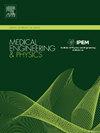Bimetallic nanoprobe strip for the detection of human chorionic gonadotrophin in pregnancy
IF 2.3
4区 医学
Q3 ENGINEERING, BIOMEDICAL
引用次数: 0
Abstract
A novel nanotechnology-based approach was developed to enhance the accuracy and reliability of pregnancy detection to address the limitations of conventional kits like PregaNews, First Response, Accu-Clear, EPT (Error Proof Test), etc. which are based on the enzyme-linked immunosorbent assay (ELISA) method. Such conventional methods often suffer from complex procedures, low precision (33 %), cross-reactivity, and false positives. The developed new diagnostic platform employed a lateral flow assay-based gold-silver nanoprobe (GSNPs) system conjugated with 3-mercaptopropionate and monoclonal antibody 2 (mAb2), pre-dispersed on biodegradable Whatman filter paper and coupled with a smartphone-based application for the detection of hCG in pregnancy. The GSNPs with a particle size of 325.1 ± 0.64 nm, exhibited superior catalytic efficiency (0.29 to 0.37 nm) with significant specificity, and reliability in comparison to digital color analysis via RGB (red, green, blue) and HSV (hue, saturation, value) algorithmic model. This nanotechnology-based system demonstrated a wide detection range (0.4–2.4ng/mL) with a low limit of detection (LOD) at 0.79 ng/mL and limit of quantification (LOQ) at 9.67 ng/mL. The detection of pathological urine was consistent with the artificial urine sample at R2=0.9796 and showed linear relationship with saturation value (y = 5.1849x+3.4559). The biodegradable and portable diagnostic strip generates minimal bio-waste and offers eco-friendly disposal. This platform tool-based strip enables sensitive, rapid, user-friendly, and cost-effective detection of hCG compared to conventional pregnancy tests. The integration of bimetallic nanoprobe strip with smartphone technology ensures ease of accessibility, high precision, and environmental sustainability to increase the demand for such reliable and economic diagnostic tool.
双金属纳米探针条用于妊娠期人绒毛膜促性腺激素的检测
针对PregaNews、First Response、Accu-Clear、EPT (Error Proof Test)等基于酶联免疫吸附试验(ELISA)的常规检测试剂盒的局限性,提出了一种基于纳米技术的新方法,以提高妊娠检测的准确性和可靠性。这些传统方法通常存在操作复杂、精度低(33%)、交叉反应性和假阳性等问题。开发的新诊断平台采用基于侧流分析的金-银纳米探针(GSNPs)系统,结合3-巯基丙酸和单克隆抗体2 (mAb2),预分散在可生物降解的Whatman滤纸上,并结合基于智能手机的应用程序来检测妊娠期hCG。与采用RGB(红、绿、蓝)和HSV(色相、饱和度、值)算法模型的数字颜色分析相比,粒径为325.1±0.64 nm的gsnp具有更高的催化效率(0.29 ~ 0.37 nm)和特异性和可靠性。该体系检测范围广(0.4 ~ 2.4ng/mL),低检出限(LOD)为0.79 ng/mL,定量限(LOQ)为9.67 ng/mL。病理尿液与人工尿液检测结果一致,R2=0.9796,与饱和值呈线性关系(y = 5.1849x+3.4559)。可生物降解和便携式诊断条产生最小的生物废物,并提供环保处理。与传统的妊娠试验相比,该平台基于工具的试纸条可实现敏感、快速、用户友好和经济高效的hCG检测。双金属纳米探针条与智能手机技术的集成确保了易用性、高精度和环境可持续性,从而增加了对这种可靠和经济的诊断工具的需求。
本文章由计算机程序翻译,如有差异,请以英文原文为准。
求助全文
约1分钟内获得全文
求助全文
来源期刊

Medical Engineering & Physics
工程技术-工程:生物医学
CiteScore
4.30
自引率
4.50%
发文量
172
审稿时长
3.0 months
期刊介绍:
Medical Engineering & Physics provides a forum for the publication of the latest developments in biomedical engineering, and reflects the essential multidisciplinary nature of the subject. The journal publishes in-depth critical reviews, scientific papers and technical notes. Our focus encompasses the application of the basic principles of physics and engineering to the development of medical devices and technology, with the ultimate aim of producing improvements in the quality of health care.Topics covered include biomechanics, biomaterials, mechanobiology, rehabilitation engineering, biomedical signal processing and medical device development. Medical Engineering & Physics aims to keep both engineers and clinicians abreast of the latest applications of technology to health care.
 求助内容:
求助内容: 应助结果提醒方式:
应助结果提醒方式:


